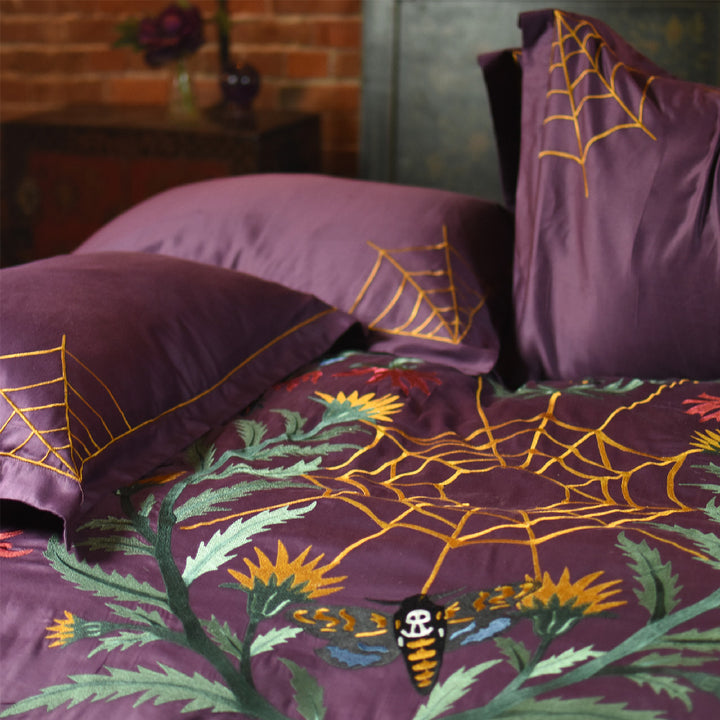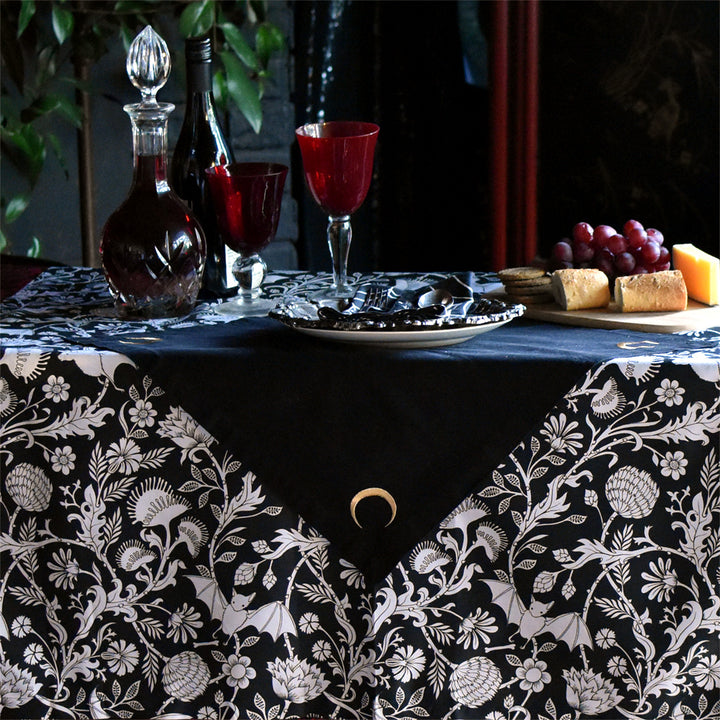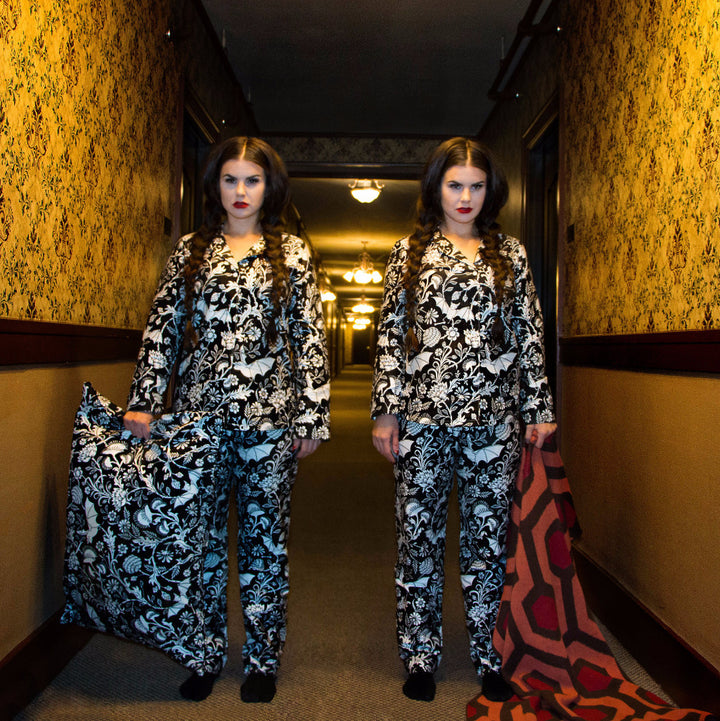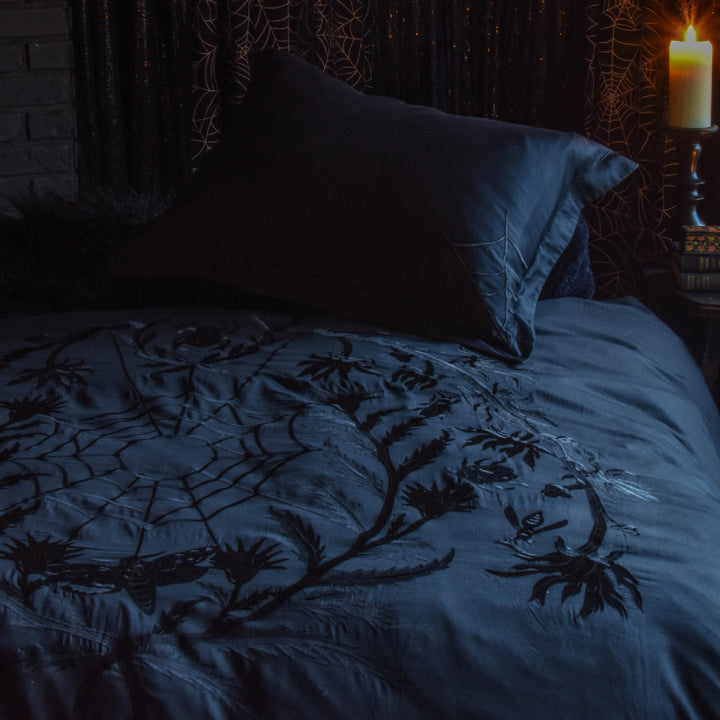What Is Toile? A Bold Take On A Classic Fabric

Definition: Toile is a printed fabric with intricate, repeat patterns – typically pastoral scenes, mythological imagery, or narrative tableaus. The name originates from the French phrase “toile de Jouy,” meaning “cloth from Jouy,” a town near Paris where it gained popularity in the 18th century.
Design Science: Toile uses a single-color ink transfer process on cotton or linen to create detailed scenes. Its delicate linework mimics etching and engraving styles, making it almost like storytelling wallpaper. In modern applications, especially with brands like Sin in Linen, the design often incorporates bolder, edgier themes while maintaining the same aesthetic foundation.
Examples:
- Classic French Toile: Depicts farming, floral gardens, or neoclassical vignettes.
- Sin in Linen’s Fetish Al Fresco Toile: Replaces traditional narratives with playful, provocative scenes celebrating modern identity and sensuality.
Fact: Toile was first widely popular in France during the late 1700s. It was originally printed on copper plates before evolving into screen and digital printing methods today. It’s been used everywhere – from Marie Antoinette’s decor to modern fashion runways – and now, your bedroom.
Key Takeaways:
- Toile is a decorative fabric with pastoral or scenic prints, traditionally in a single color on white or cream.
- Sin in Linen reimagines toile with bold, edgy illustrations for a one-of-a-kind look.
- Toile can be styled in bedrooms, dining rooms, and eclectic spaces to add drama and personality.
If you hear the word "toile" and think of quaint countryside scenes or vintage teacups, you’re not wrong – but there’s a lot more to this classic textile than meets the eye. Traditionally, toile (short for “toile de Jouy”) originated in 18th-century France and featured delicate pastoral scenes printed in a single color on a white or cream background. It was soft, romantic, and refined, but it provides the perfect foundation for reimagined designs.
Fast-forward to now, and Sin in Linen has taken toile to an entirely new place. Think edge, attitude, and playfulness layered over a historically “proper” fabric. It’s all the charm of classic toile with no stiffness – perfect for people who like a little rebellion to crack their whip.
The Origins and Evolution Of Toile
Toile has always been about storytelling. Originally produced in Jouy-en-Josas, France, in the late 1700s, these fabrics depicted idealized pastoral life, historical events, or mythological scenes – printed in a single color, often deep blue, red, or black. They were a way to bring art and narrative into everyday life, especially in bedrooms and drawing rooms.
Over the centuries, toile made its way into everything from wallpaper to upholstery to fashion. In the 20th century, it became synonymous with traditional, often French-inspired, home decor. But like anything with deep roots, toile has proven surprisingly adaptable. Modern designers have embraced its potential as a backdrop for satire, storytelling, and even social commentary. That’s precisely what Sin in Linen does – honoring the technique while flipping the subject matter.
Fetish Al Fresco: Sin In Linen’s Wild Spin On A Classic
Toile might be centuries old, but the Fetish Al Fresco collection is anything but. This line redefines what toile can be, blending cheeky, vintage erotic imagery with the timeless style of scenic illustration. You’ll still find that classic monochrome palette and detailed line work, but now those charming vignettes come with a wink and a nudge. It’s playful. It’s artistic. And it’s designed to make a statement.
Pillowcases And Shams: Where Tradition Gets A Twist
Looking for a low-commitment way to play with toile? The Fetish Al Fresco Pillowcases and Shams are a subtle but bold starting point. From afar, they look like classic French toile. Up close, you’ll notice the provocative storytelling woven into each design. It’s a visual double-take that adds just the right amount of edge to your Medscape.
Made from soft, breathable cotton, they’re as cozy as they are daring – and thanks to their easy-care construction, they're durable enough for everyday use.
The Comforter That Starts Conversations
The Fetish Al Fresco Comforter is a statement piece. With a bold print that reinterprets toile in a modern, suggestive, and unforgettable way, this comforter turns your bed into a place for personalization and identity. And it doesn’t just look good. It’s filled for warmth and wrapped in soft, durable cotton so you can snuggle up in your bold aesthetic.
The Square Pillow: Because Every Look Needs A Finishing Touch
Accent pillows are like punctuation for your furniture, and the Fetish Al Fresco Square Pillow finishes your space with a playful flair. Toss it onto your bed, couch, or a velvet chair to break the rules and elevate your look. It’s soft, it’s stylish, and it’s guaranteed to get attention.
Dinner Napkins With Serious Personality
Toile at the table? Absolutely. The Fetish Al Fresco Dinner Napkins bring the collection’s iconic line art to your dinner party setup. These 100% cotton napkins are durable, washable, and memorable. Whether you’re hosting a dinner with friends or want to elevate your weeknight routine, they’re an easy way to add art and attitude to the table.
Why Toile Still Works – And Why Sin In Linen Makes It Better
Toile has stood the test of time for a reason: it’s decorative, versatile, and works in many spaces. But Sin in Linen’s take on toile isn’t just about nostalgia. It’s about reimagining tradition in a way that feels now and refreshing. And the materials? They’re built for everyday living. Soft, breathable, easy to care for.
Toile As A Conversation Starter
What makes toile so compelling in modern spaces isn’t just its look – it’s how it tells a story. Every design in Sin in Linen’s reinterpretation invites a second glance, a little curiosity, and a lot of personality. Whether your guests notice immediately or take a second look during dinner, toile becomes a talking point that blends art with function.
Toile In Unexpected Places
You might think toile belongs only in bedding or curtains, but that’s just scratching the surface. Toile-printed napkins? Throw blankets? Absolutely. The playful pattern from Sin in Linen can liven up powder rooms, walk-in closets, and even small reading nooks. A single square pillow or throw blanket can offer just the right amount of attitude in spaces that need a little lift.
The Future Of Toile Design
If the past few years have shown us anything, tradition and rebellion aren’t opposites – they’re creative fuel. As designers push the boundaries of what toile can represent, we’ll see even more irreverent takes, unexpected applications, and thoughtful remixes. Sin in Linen’s version of toile is just one part of a growing movement to take old-world aesthetics and give them bold, modern lives.
The Symbolism Behind Toile Designs
Toile patterns may look decorative at first glance, but they’ve always been a way to reflect culture, politics, and values of the time. Traditional toile often portrayed idyllic rural life or historical scenes.
Sin in Linen’s take on toile leans into this history while modernizing the narrative, choosing bold, subversive imagery that sparks curiosity and challenges expectations. It’s a reminder that textiles don’t just fill space – they communicate.
Sustainability And Toile: Style With A Conscience
With more consumers prioritizing sustainability, the appeal of high-quality cotton toile is rising. Sin in Linen’s toile is made with 100% cotton, designed to last through years of use and laundering. This makes it a smart, low-waste alternative to fast-fashion or disposable decor trends.
Investing in timeless patterns like toile means you’re choosing a style that doesn’t cycle out seasonally and fabric that wears beautifully over time.
A Modern Moodboard: Toile Beyond Black And White
While traditional toile relies on high-contrast monochrome, the future of toile design includes bolder colorways and layered styles. While Sin in Linen’s toile focuses on black and white as the dominant hues, don’t be afraid to mix your toile bedding with jewel tones, soft grays, or even metallics. The print speaks volumes – so pair it with colors that reflect your mood, season, or aesthetic.
Toile And Texture: Elevating Your Space
Pairing toile with different textures brings out its best features. Try it with crushed velvet for a rich, moody vibe, or layer it next to silky bamboo sheets to add a sleek finish. Add a faux fur throw, a matte ceramic lamp, or a high-gloss bedside table, and suddenly, the print becomes part of a bigger, bolder narrative.
Mixing Historical With Hypnotic
Toile offers a bridge between centuries. Pair a Sin in Linen comforter or pillowcase with vintage-inspired furniture, like a carved headboard or a weathered vanity. Or, go the opposite route: set your toile against modern acrylic pieces, minimal lamps, or industrial shelving. The contrast amplifies the story, proving that toile isn’t tied to one era. It travels well—and stylishly – between them.
Why Toile Appeals Across Generations
Toile’s longevity isn’t just about nostalgia – it’s about versatility. Grand millennials love it for its vintage vibes. Minimalists use it as a sharp focal point. Maximalists layer it with everything. It bridges the gap between traditional and contemporary, feminine and edgy, soft and bold. Sin in Linen’s Fetish Al Fresco collection taps into this wide-ranging appeal, giving every generation a reason to fall in love with toile all over again.
Toile For All Tastes
Maybe you love maximalism. You could keep things minimal but crave one standout accent. Toile is flexible like that. Its detailed linework and monochrome styling make blending into all kinds of aesthetics easy. Whether you’re outfitting a gothic bedroom, a Parisian-inspired loft, or just your favorite reading chair, toile can meet you there, with just the right amount of flair.
Final Thoughts
Toile is more than just a pattern – it’s a point of view. It tells stories, sparks conversation, and adds personality to any room. And with Sin in Linen’s rebellious take on this classic design, toile has officially shed its old-fashioned reputation. It’s art for your bed, your couch, your table. It’s tradition with an edge.
So if you’ve ever wondered whether something as classic as toile can still feel fresh, bold, and totally you, the answer is yes. And it’s waiting in every stitch of the Fetish Al Fresco collection.
Read Also:
- Shadowed Corridors and Classical Wisdom: The Timeless Appeal of Dark Academia
- Softness, Stillness, and Seduction: The Art of Loving Yourself
- Weave the spirit of Absinthe into your home.
Frequently Asked Questions About Toile
What is toile made of?
Traditionally, toile is made from cotton or linen. Sin in Linen’s toile is printed on 100% breathable cotton for softness and durability.
Is toile still in style?
Absolutely. Toile is making a comeback – especially when it’s reimagined in bold, modern ways like the Fetish Al Fresco collection.
Can I mix toile with other patterns?
Yes! Pair toile with solids, stripes, or small-scale prints for a layered, eclectic look.
How do I care for toile fabric?
Most toile fabric, including Sin in Linen, is machine washable. To keep the print vibrant, use a gentle detergent and avoid bleach.
Does toile only work in traditional spaces?
Not at all. When styled with contrast and intention, toile can look amazing in contemporary, eclectic, and even minimalist homes.
Can I use toile outside of the bedroom?
Definitely. Toile looks stunning in dining rooms, powder rooms, and living rooms.
How is modern toile different from traditional toile?
Modern toile, like Sin in Linen’s design, replaces pastoral scenes with edgy, unexpected illustrations, offering a bold reinterpretation of a classic pattern.
Can toile be considered a gender-neutral pattern?
Yes. While often associated with femininity, our bedding is for anyone and any space. All that matters is that your space reflects YOU.
What kind of rooms benefit most from toile?
Toile works well in bedrooms, reading nooks, and dining areas – anywhere you want to create visual interest or spark a conversation.










































Leave a comment